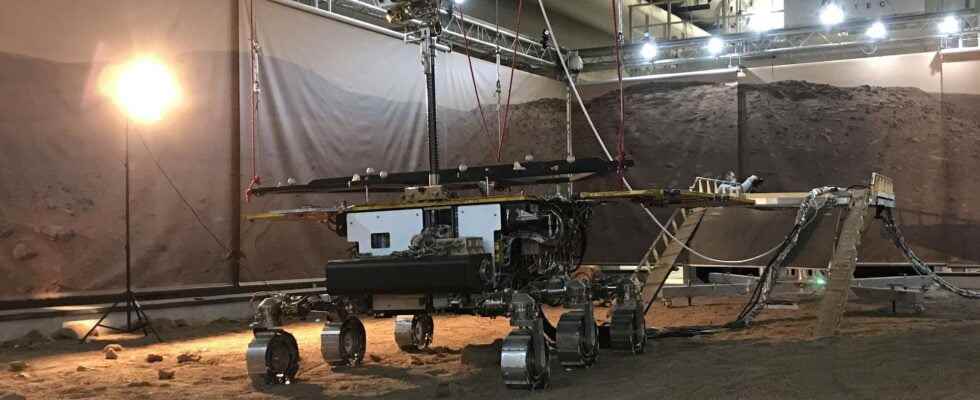Capping off an incredible year of preparations, the ExoMars Rosalind Franklin rover descended from its landing pad for the first time in a simulation, providing confidence for the mission launch in September.
You will also be interested
[EN VIDÉO] ExoMars mission: in search of life on the Red Planet The ExoMars mission is among the most ambitious ever undertaken on the Red Planet. Its purpose is to search for traces of past or present lives. ESA offers us a video preview of this exciting mission.
ESA’s Rosalind Franklin rover begins the year with months of maintenance and successful functional testing under its belt. All of its instruments are ready for take-off, with only a few minor tweaks left to complete this month. “The rover is ready, and with the recent successful parachute drop test, we are confident that we will be there for the launch in September”said Pietro Baglioni, team leader of ESA’s ExoMars rover.
Once every two years and for ten days only, celestial mechanics allow a space vehicle to reach Mars from Earth in a minimum time, about nine months.
The Rosalind rover is now housed in an ultra-clean clean room at Thales Alenia Space’s facilities in Turin, Italy, right next to its companion Kazachok, the landing platform. After a final review in April, all spacecraft components, i.e. rover, descent module, landing pad and transport module, will be transported to the launch site at Baikonur, Kazakhstan, in preparation for takeoff. “Just before this last trip to Earth, we will upload the final version of the software which will allow the rover to explore Mars autonomously”, explains Pietro.
Descent of Amalia, twin of the Rosalind Franklin rover, from its platform. © ESA
First spins on Mars
After the harrowing experience of descending to the surface of Mars, a highly anticipated moment of the ExoMars mission will be when the Rosalind rover descends from the landing pad and rolls onto Martian soil for the first time. The descent of Kazachok is a carefully choreographed and rehearsed operation on Earth by the engineers.
the twin ESA’s Rosalind Franklin rover successfully descended from the platform during recent tests in the Martian Terrain Simulator installed at Altec’s facilities in Turin.
Even though the rover only rolls for 15 minutes during this stage, the whole process will take a few Martian days. After landing, it will take him more than a week to unfold its wheels, deploy the mast and perform other checks. “The descent is a long and crucial operation. We have to do it gently and do it very slowly for maximum safety”, explains Andrea Merlo, Head of robotics of ExoMars for Thales Alenia Space.
The landing platform has two exit ramps, one forward and one aft. The Rosalind rover is designed to negotiate the steep slope of the ramps, but it will be up to the control team on Earth to choose the safest ramp to descend from the platform. “The story of this Mars rover will begin once its six wheels hit the surface. We feel ready and look forward to the real mission”, says Andrea.
The Amalia rover
ExoMars’ twin rover, until now known as the “ground test model”, has a new name: Amalia. This test model takes its name from Professor Amalia Ercoli Finzi, an astrophysicist renowned for her extensive experience in spaceflight dynamics.
Amalia was the first woman to earn an aeronautical engineering degree in Italy. In addition to being a scientific advisor for the ESA and the Nasa, she designed the Philae lander drill of Rosetta and has worked hard for the development of the ExoMars drill 20 years ago. “I am flattered and honored that this essential element of the ExoMars mission gate my name. Mars is waiting for us », she said after receiving the news.
Engineers use the Amalia rover to recreate different scenarios and help them make decisions that will keep the Rosalind rover safe in the harsh Mars environment. The model is fully representative of what the rover will be able to do on the Red Planet. “We can start having fun. We will use Amalia to conduct risky operations, from piloting the Martian slopes to finding the best trajectory for science operations to drilling and analyzing rocks.”, explains Andrea.
Amalia has so far demonstrated its ability to drill up to 1.7 meters deep and operate all its instruments while sending scientific data to the Rover Operations Control Center (Rocc), the operational center that will orchestrate the movements on Mars of the rover built in Europe.
Teamwork
It took an extraordinary effort to get to the starting line in time; two teams worked in rotation and without taking a break in 2021, despite the disruptions linked to the pandemic of the Covid-19.“The cooperation between European and Russian industries, the coordination between space agencies and the work of the technical teams have been remarkable”, welcomes Pietro.
Teams solved critical issues by working in parallel, such as the parachute system and descent module electronics, with enough headroom for a launch in September 2022. Launch preparations have begun in Baikonur and a dedicated support team is in place at the Esoc center in Darmstadt, Germany.
The ESA-Roscosmos orbiter Trace Gas Orbiter awaits the arrival of ExoMars on the Red Planet. In addition to its own science mission, the orbiter relays data from the rover Perseverance from NASA. The Chinese rover Zhurong has also been resting on the Martian surface since 2021.
“There is not long to wait before the European rover can finally join the others martian rovers in 2023 with a first-rate scientific laboratory on board”, explains Pietro.
Interested in what you just read?
